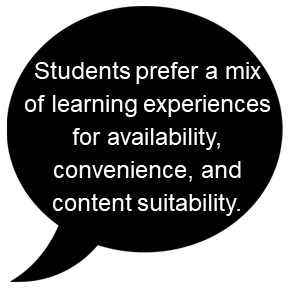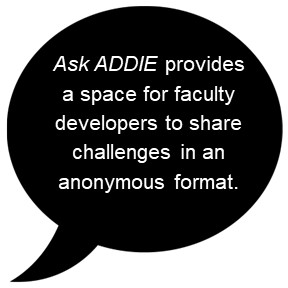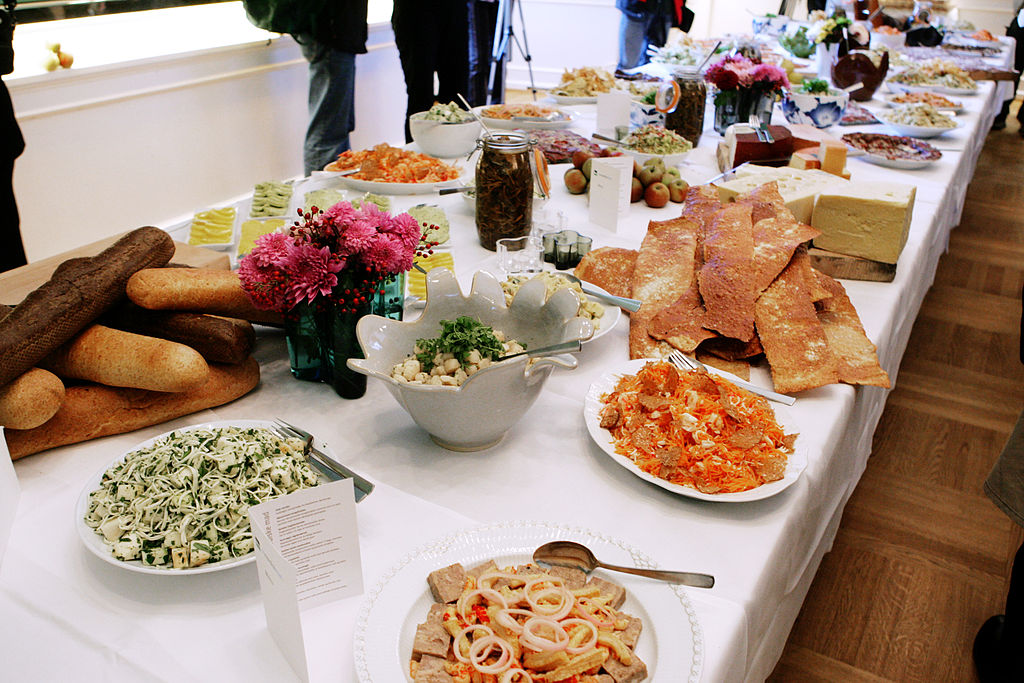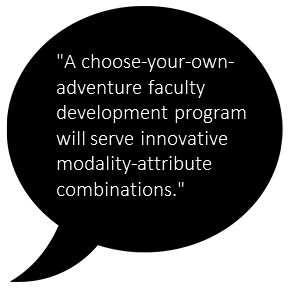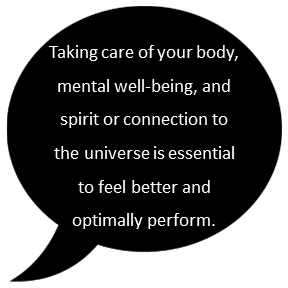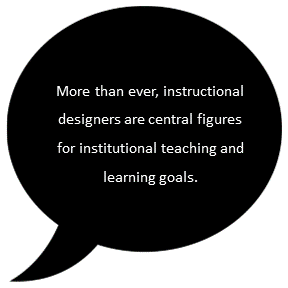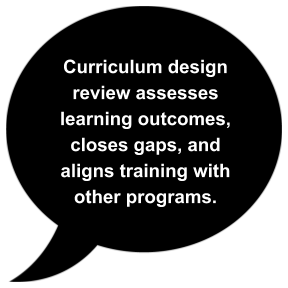Author: Dr. Denise Lowe, University of Central Florida
Editor: Dr. Florence Williams & Bren Bedford, University of Central Florida
Dear ADDIE,
My university has recently added several new, accelerated course formats in various weekly time lengths for both online and traditional courses, e.g., 3-week, 8-week, 10-week. Many instructors assisted by instructional designers are questioning how they should redesign their online courses to meet a significantly reduced time frame of instruction. Given the challenge of maintaining academic rigor in a shorter time frame, what practical strategies can instructors employ to achieve this?
Signed,
Fast Track
Dear Fast Track,
You are not alone! The scenario described is becoming a regular feature across many institutions in efforts to meet student demand for more responsive course enrollments and reduced time to graduate among other factors. This is an exciting time and provides opportunities for growth, both for faculty and instructional designers as they navigate these new environments together. However, along with opportunities come challenges, as faculty may be overwhelmed with trying to identify and condense critical course concepts and activities to fit within accelerated formats. By working together and sharing best practices, faculty and instructional designers can successfully navigate these new environments and create high-quality accelerated courses.
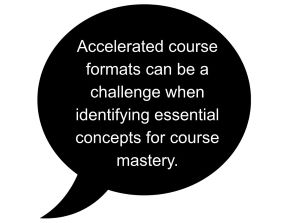
Besides the instructor’s potential learning curve for these formats, students may also need extra support to manage the workload in a compressed time frame. Many students are juggling several responsibilities in their personal lives, making ideas of earlier graduation dates or shortened semesters enticing for many. However, the focus and time management skills needed to be successful in such courses are critical to understand, and students will ultimately be looking to their instructors to lead the way.
One of the most challenging aspects of course redesign for accelerated formats is to determine the content and concepts that are essential for discipline mastery. Equivalency theory suggests that learning experiences for in-person or online learners should be similar across formats. Considering instructional factors and course design, both traditional and accelerated formats can offer equivalent experiences.
There may be several options to course conversions, but faculty should be mindful of student cognitive overload. Effective course design – or redesign – is most effective when it combines objective learning outcomes and content organization with collaborative learning, authentic tasks, and critical reflection. Overall, accelerated course conversions include focusing on four main areas:
| Course reorganization and planning | This is planning for essential topics and concepts. Consider using the “must know”, “need to know”, and “nice to know” strategy for identifying what is essential to course mastery. Look for thematic similarities or redundancies within your course topics. |
| Course redesign | Re-evaluate types of assessments or activities used and look for course tools to engage students with the content. Use “reframing” as a way of modifying your perspective of the course. Active learning strategies often align well with course concepts and enhances learning by doing. |
| Course delivery | Communicate, communicate, communicate! Student feedback is paramount in accelerated formats to build confidence that they are on the right track. Find ways to relax the learning environment, even within such a short time frame, such as reflective discussions and other critical thinking activities. |
| Student resources | Provide students with success resources that can help focus their attention, time, and effort.Be prepared with these resources at the start of the course to minimize early setbacks. How to Succeed in a 3-Week, Fully Online Winter Session Course from the University of Maine is one such resource. |
The University of Central Florida (UCF) provides an invaluable resource for faculty considering the development of accelerated courses: Accelerated Course Design for Educators. As a starting point, interactive decision trees may help faculty consider the nuances of teaching accelerated courses they may not have considered. In addition, using AI chatbots (Course Condenser Tool) to help identify course redundancies and to realign content to fit within specific time frames can make this an easier conversion process. Course Maps may assist faculty in keeping things on track and ensure alignment of content and activities. Infographics provide quick, easily digestible strategy tips and tricks, such as the one shown here:
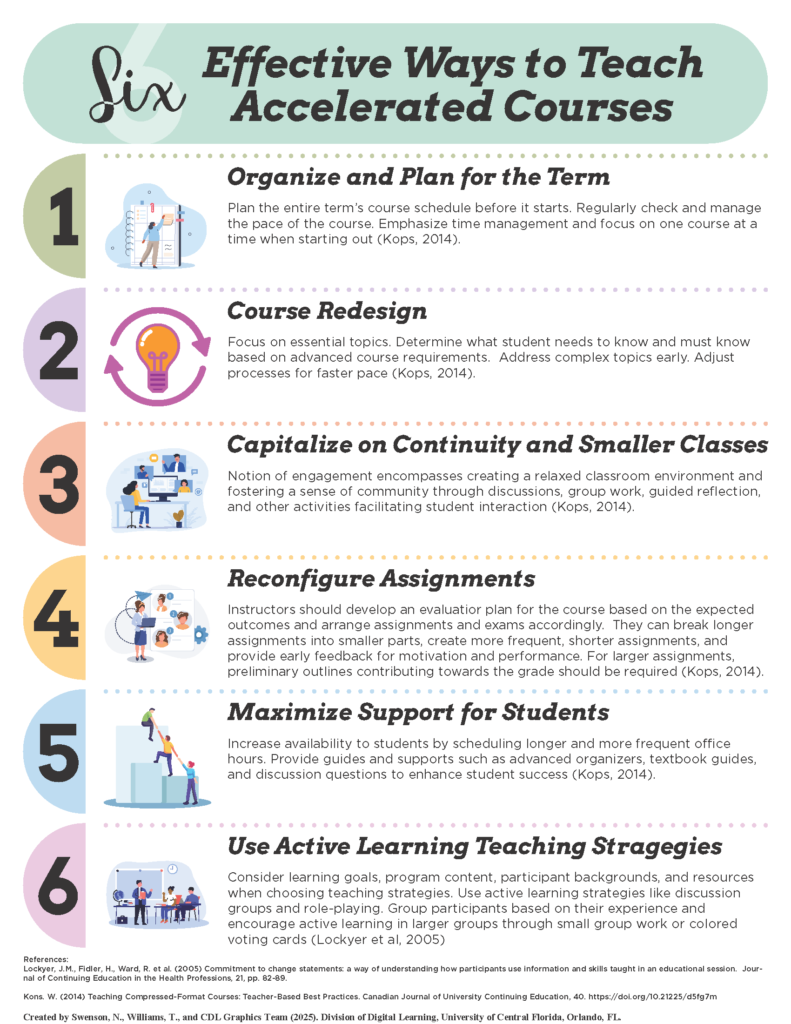
The UCF accelerated course conversion resources include support for students as well. Are Accelerated Courses Right for You? is a student success resource providing an interactive decision tree to help students determine if enrollment in accelerated courses is a good path for them. Faculty could provide this resource as a link for students within their course materials. An infographic geared to student success also provides a quick look at useful strategies and tips as part of this resource.
What other ideas or plans for accelerated courses have you implemented or are exploring at your higher education institution? Please share your thoughts with our TOPkit community on LinkedIn!
References
Bellefeuille, G. (2006). Rethinking reflective practice in social work education: A blended constructivist and objectivist instructional design strategy for a web-based child welfare practice course. Journal of Social Work Education, 42(1), 85-103.
Ferguson J, DeFelice A. (2010). Length of Online Course and Student Satisfaction, Perceived Learning, and Academic Performance. International Review of Research in Open and Distance Learning [serial online]. 11(2):73-84. Available from: ERIC, Ipswich, MA.
Hudson, Walter. (2025, February). California community colleges launch initiative to expand shortened courses. Diverse: Issues in Education. https://www.diverseeducation.com/institutions/community-colleges/article/15738240/california-community-colleges-launch-initiative-to-expand-shortened-courses?
Jowallah, R. (2025). Course Condenser Tool. ChatGPT. https://chatgpt.com/g/g-LkoGIwsbu-course-condenser
Lapsley, R., Kulik, B., Moody, R., & Arbaugh, J. B. (2008). Is identical really identical? An investigation of equivalency theory and online learning. Journal of Educators Online, 5(1).
Lowe, D., Jowallah, R., McNulty, R., Swenson, N., Williams, T. (2025, March). Accelerated course design for educators. University of Central Florida Division of Digital Learning. https://cdl.ucf.edu/teach/strategies/accelerated-course-design/
Lowe, D., Jowallah, R., McNulty, R., Swenson, N., Williams, T. (2025, March). Are accelerated courses right for you? University of Central Florida Division of Digital Learning. https://cdl.ucf.edu/support/student/accelerated-courses/
Swenson, N. & Williams, T. (2025). Six effective ways to teach accelerated courses [Infographic for faculty]. University of Central Florida, Division of Digital Learning. https://cdl.ucf.edu/teach/strategies/accelerated-course-design/
Swenson, N. & Williams, T. (2025). 5 steps for success in accelerated courses [Infographic for students]. University of Central Florida, Division of Digital Learning. https://cdl.ucf.edu/support/student/accelerated-courses/
Swenson, N., McNulty, R., Williams, T., & Woodland, K. (2025). Student decision tree [Interactive decision tree]. University of Central Florida, Division of Digital Learning. https://cdl.ucf.edu/support/student/accelerated-courses/
Swenson, N., McNulty, R., Williams, T., & Woodland, K. (2025). Faculty decision tree [Interactive decision tree]. University of Central Florida, Division of Digital Learning. https://cdl.ucf.edu/teach/strategies/accelerated-course-design/
University of Maine. (n.d.). How to succeed in a 3-week, fully online winter session course. https://umaine.edu/wintersession/how-to-succeed/
Watson, S.W., & Rutledge, V.C. (2005). Online course delivery and student satisfaction. ERIC document ED490363.


